Optimizing Heat Treatment to Improve the Microstructures and Mechanical Properties of 5CrNiMoV Steel
Abstract
1. Introduction
2. Materials and Methods
2.1. Materials
2.2. Heat Treatment Process
2.3. Microstructure and Mechanical Properties Characterization
3. Results and Discussion
3.1. Dissolution of Carbides
3.2. Mechanical Properties
3.3. Microstructures
3.4. Precipitation Strengthening
3.5. Tensile Fracture
4. Conclusions
- (1)
- Proper heat treatment enhances the mechanical properties of 5CrNiMoV. A balance of strength and ductility is achieved with a UTS of 1230 MPa and an EL of 7.0% after quenching at 1050 °C, pre-tempering at 600 °C, and tempering at 550 °C. Furthermore, intercritical quenching at 1050 °C, pre-tempering at 600 °C, and tempering at 550 °C results in a higher EL of 8.2% with a UTS of 1220 MPa.
- (2)
- Pre-tempering at 600 °C and tempering at 550 °C not only promotes the precipitation of carbides, but also inhibits their coarsening, effectively enhancing precipitation strengthening and contributing to a 255 MPa increase in the YS. Additionally, the decrease in the solid solution of C and Cr elements in the α-Fe matrix due to increased carbide precipitation reduces the lattice micro-strain and dislocation density, thereby improving ductility.
- (3)
- After intercritical quenching and tempering, the microstructure is composed of tempered martensite and pearlite. The high strength can be ascribed to the tempered martensite. The enhanced ductility is attributed to the decrease in micro-strain and dislocation density, as well as the mixed structures of tempered martensite and pearlite, which serve to hinder crack propagation during tensile deformation.
Author Contributions
Funding
Data Availability Statement
Conflicts of Interest
References
- Huang, W.; Lei, L.; Fang, G. Microstructure evolution of hot work tool steel 5CrNiMoV throughout heating, deformation and quenching. Mater. Charact. 2020, 163, 110307. [Google Scholar] [CrossRef]
- Hu, Z.; Wang, K. Evolution of Dynamic Recrystallization in 5CrNiMoV Steel during Hot Forming. Adv. Mater. Sci. Eng. 2020, 2020, 4732683. [Google Scholar] [CrossRef]
- Jiang, W.; Wang, S.; Deng, Y.; Guo, X. Microstructure stability and high temperature wear behavior of an austenite aging steel coating by laser cladding. Mater. Charact. 2022, 184, 111700. [Google Scholar] [CrossRef]
- Kundu, A.; Field, D.P. Influence of microstructural heterogeneity and plastic strain on geometrically necessary dislocation structure evolution in single-phase and two-phase alloys. Mater. Charact. 2020, 170, 110690. [Google Scholar] [CrossRef]
- Dobrzanski, L.; Mazurkiewicz, J.; Hajduczek, E. Effect of thermal treatment on structure of newly developed 47CrMoWVTiCeZr16-26-8 hot-work tool steel. J. Mater. Process. Technol. 2004, 157, 472–484. [Google Scholar] [CrossRef]
- Wang, H.; Li, J.; Shi, C.B.; Li, J.; He, B. Evolution of Carbides in H13 Steel in Heat Treatment Process. Mater. Trans. 2017, 58, 152–156. [Google Scholar] [CrossRef]
- Yu, X.-S.; Wu, C.; Shi, R.-X.; Yuan, Y.-S. Microstructural evolution and mechanical properties of 55NiCrMoV7 hot-work die steel during quenching and tempering treatments. Adv. Manuf. 2021, 9, 520–537. [Google Scholar] [CrossRef]
- Zhou, Q.; Wu, X.; Shi, N.; Li, J.; Min, N. Microstructure evolution and kinetic analysis of DM hot-work die steels during tempering. Mater. Sci. Eng. A 2011, 528, 5696–5700. [Google Scholar] [CrossRef]
- Zhu, J.; Zhang, Z.; Xie, J. Improving strength and ductility of H13 die steel by pre-tempering treatment and its mechanism. Mater. Mater. Sci. Eng. A 2019, 752, 101–114. [Google Scholar] [CrossRef]
- Kang, C.; Liu, F.; Jiang, Z.; Zhang, H.; Ding, S. Effect of nitrogen content on solidification behaviors and morphological characteristics of the precipitates in 55Cr17Mo1VN plastic die steel. Mater. Charact. 2022, 194, 112340. [Google Scholar] [CrossRef]
- Sun, J.; Wang, H.; Xu, B.; Jiang, L.; Guo, S.; Sun, X.; Yu, D.; Liu, F.; Liu, Y. Making low-alloyed steel strong and tough by designing a dual-phase layered structure. Acta Mater. 2022, 227, 117701. [Google Scholar] [CrossRef]
- He, B.B.; Hu, B.; Yen, H.W.; Cheng, G.J.; Wang, Z.K.; Luo, H.W.; Huang, M.X. High dislocation density-induced large ductility in deformed and partitioned steels. Science 2017, 357, 1029–1032. [Google Scholar] [CrossRef]
- Li, Y.; Yuan, G.; Li, L.; Kang, J.; Yan, F.; Du, P.; Raabe, D.; Wang, G. Ductile 2-GPa steels with hierarchical substructure. Science 2023, 379, 168–173. [Google Scholar] [CrossRef] [PubMed]
- da Silva, E.P.; Xu, W.; Fojer, C.; Houbaert, Y.; Sietsma, J.; Petrov, R.H. Phase transformations during the decomposition of austenite below M-s in a low-carbon steel. Mater. Charact. 2014, 95, 85–93. [Google Scholar] [CrossRef]
- Shuai, J.; Zhao, J.; Lei, L.; Zeng, P.; Wu, X.; Sun, L. Characterization of crack propagation of Incoloy 800H by the combination of DIC and XFEM. Nucl. Eng. Des. 2020, 364, 110683. [Google Scholar] [CrossRef]
- Ivanisenko, Y.; Wunderlich, R.; Valiev, R.; Fecht, H. Annealing behaviour of nanostructured carbon steel produced by severe plastic deformation. Scr. Mater. 2003, 49, 947–952. [Google Scholar] [CrossRef]
- Cheng, T.; Wang, Y.; Zhao, Y.; Lv, L.; Hu, Q.; Ma, D. Effect of remelting solution heat treatment on microstructure evolution of nickel-based single crystal superalloy DD5. Mater. Charact. 2022, 192, 112186. [Google Scholar] [CrossRef]
- Chen, J.; Kan, Q.; Li, Q.; Yin, H. Effects of grain size on acoustic emission of nanocrystalline superelastic NiTi shape memory alloys during fatigue crack growth. Mater. Lett. 2019, 252, 300–303. [Google Scholar] [CrossRef]
- Rack, H. Role of prior austenite grain-size on the tensile ductility and fracture-toughness. Scr. Metall. 1979, 13, 577–582. [Google Scholar] [CrossRef]
- Li, J.; Zhang, C.; Liu, Y. Influence of carbides on the high-temperature tempered martensite embrittlement of martensitic heat-resistant steels. Mater. Mater. Sci. Eng. A 2016, 670, 256–263. [Google Scholar] [CrossRef]
- Du, N.; Liu, H.; Cao, Y.; Fu, P.; Sun, C.; Liu, H.; Li, D. In situ investigation of the fracture of primary carbides and its mechanism in M50 steel. Mater. Charact. 2022, 186, 111822. [Google Scholar] [CrossRef]
- Wang, K.; Guo, Z.; Sha, W.; Glicksman, M.; Rajan, K. Property predictions using microstructural modeling. Acta Mater. 2005, 53, 3395–3402. [Google Scholar] [CrossRef]
- Niu, T.; Kang, Y.L.; Gu, H.W.; Yin, Y.Q.; Qiao, M.L. Precipitation Behavior and Its Strengthening Effect of X100 Pipeline Steel. J. Iron Steel Res. Int. 2010, 17, 73–78. [Google Scholar] [CrossRef]
- Gladman, T. Precipitation hardening in metals. Mater. Sci. Technol. 1999, 15, 30–36. [Google Scholar] [CrossRef]
- Cullity, B.D.; Stock, S.R. Elements of X-ray Diffraction, 3rd ed.; Addison-Wesley Publishing: Boston, MA, USA, 2001. [Google Scholar]
- Mote, V.; Purushotham, Y.; Dole, B. Williamson-Hall analysis in estimation of lattice strain in nanometer-sized ZnO particles. J. Theor. Appl. Phys. 2012, 6, 6. [Google Scholar] [CrossRef]
- Sarkar, A.; Bhowmik, A.; Suwas, S. Microstructural characterization of ultrafine-grain interstitial-free steel by X-ray diffraction line profile analysis. Appl. Phys. A 2009, 94, 943–948. [Google Scholar] [CrossRef]
- Zhao, Y.; Horita, Z.; Langdon, T.; Zhu, Y. Evolution of defect structures during cold rolling of ultrafine-grained Cu and Cu-Zn alloys: Influence of stacking fault energy. Mater. Sci. Eng. A 2008, 474, 342–347. [Google Scholar] [CrossRef]
- Chen, J.; Lei, L.; Fang, G. Grain-size effects on the temperature-dependent elastocaloric cooling performance of polycrystalline NiTi alloy. J. Alloys Compd. 2022, 927, 166951. [Google Scholar] [CrossRef]
- Sun, W.; Xu, C.; Qiao, X.; Zheng, M.; Kamado, S.; Gao, N.; Starink, M. Evolution of microstructure and mechanical properties of an as-cast Mg-8.2Gd-3.8Y-1.0Zn-0.4Zr alloy processed by high pressure torsion. Mater. Sci. Eng. A 2017, 700, 312–320. [Google Scholar] [CrossRef]
- Zhao, Y.; Bingert, J.; Topping, T.; Sun, P.; Liao, X.; Zhu, Y.; Lavernia, E. Mechanical behavior, deformation mechanism and microstructure evolutions of ultrafine-grained Al during recovery via annealing. Mater. Sci. Eng. A 2020, 772, 138706. [Google Scholar] [CrossRef]
- Huang, W.; Zhong, H.; Lei, L.; Fang, G. Microstructure and mechanical properties of multi-pass forged and annealed 42CrMo steel. Mater. Sci. Eng. A 2022, 831, 142191. [Google Scholar] [CrossRef]
- Chen, J.; Yin, H.; Sun, Q. Effects of grain size on fatigue crack growth behaviors of nanocrystalline superelastic NiTi shape memory alloys. Acta Mater. 2020, 195, 141–150. [Google Scholar] [CrossRef]
- Wang, J.; Zhao, Y.; Zhou, W.; Zhao, Q.; Huang, S.; Zeng, W. In-situ investigation on tensile deformation and fracture behaviors of a new metastable beta titanium alloy. Mater. Sci. Eng. A 2021, 799, 140187. [Google Scholar] [CrossRef]
- Chen, X.; Zhao, G.; Xu, X.; Wang, Y. Effects of heat treatment on the microstructure, texture and mechanical property anisotropy of extruded 2196 Al-Cu-Li alloy. J. Alloys Compd. 2021, 862, 158102. [Google Scholar] [CrossRef]

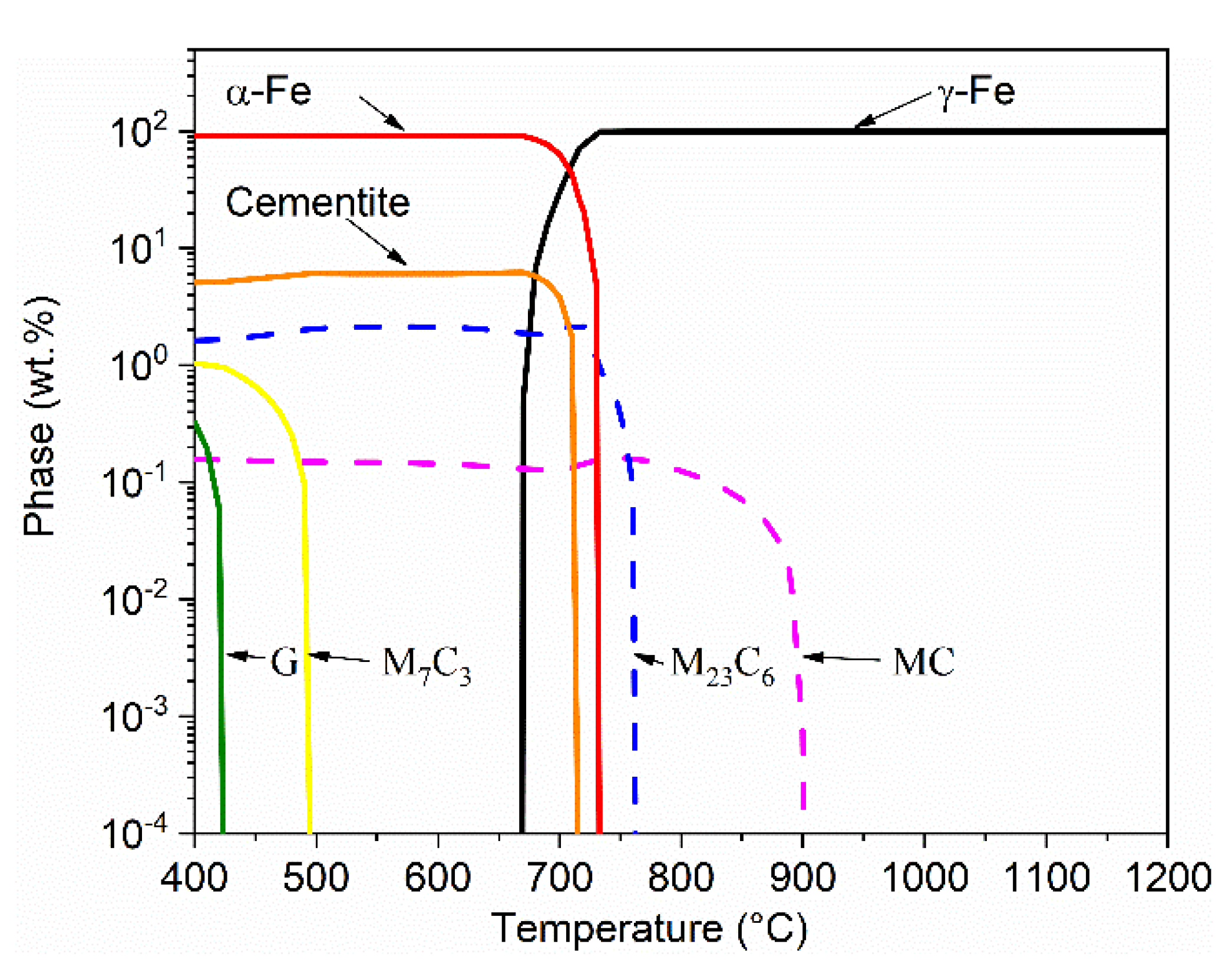
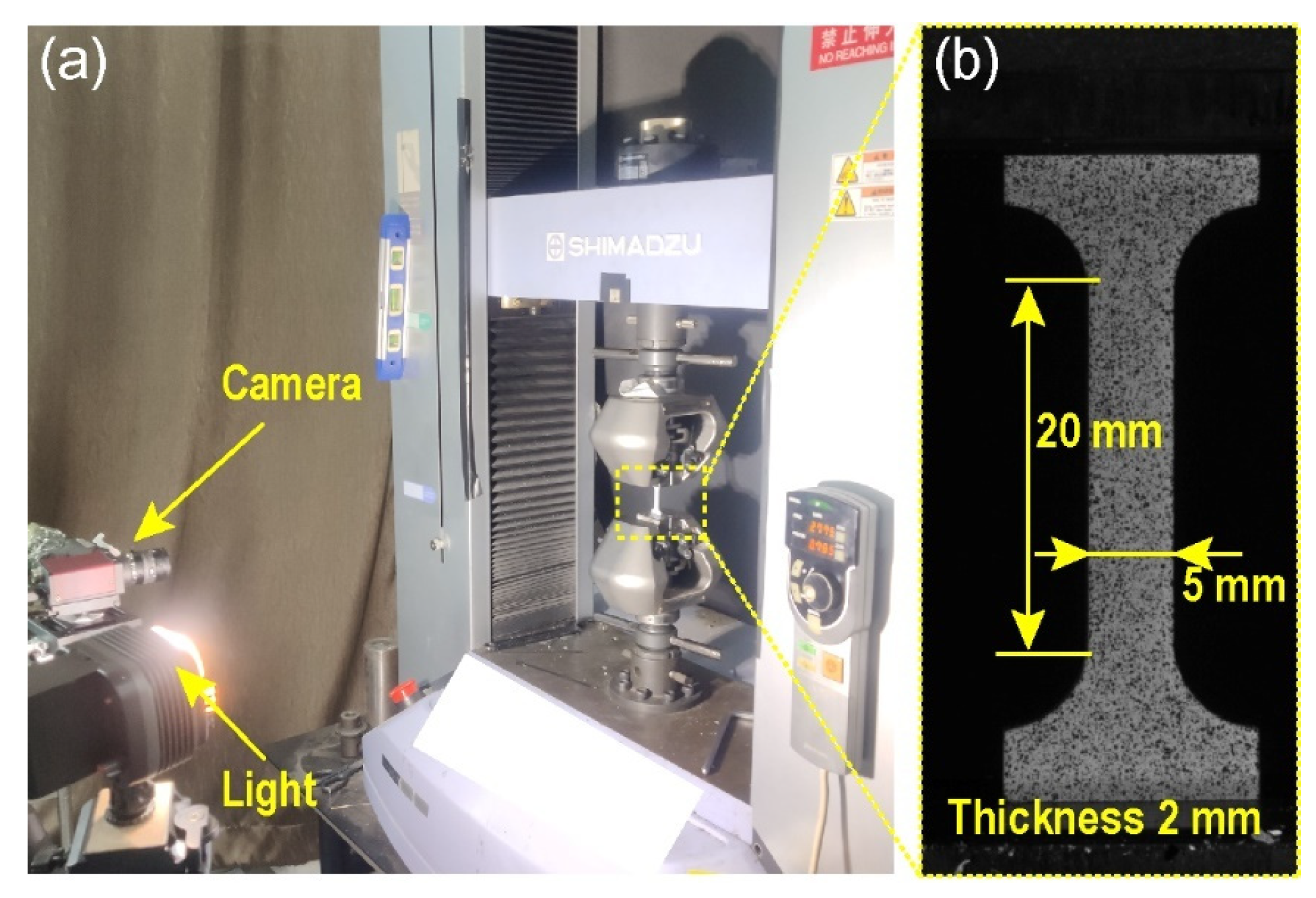
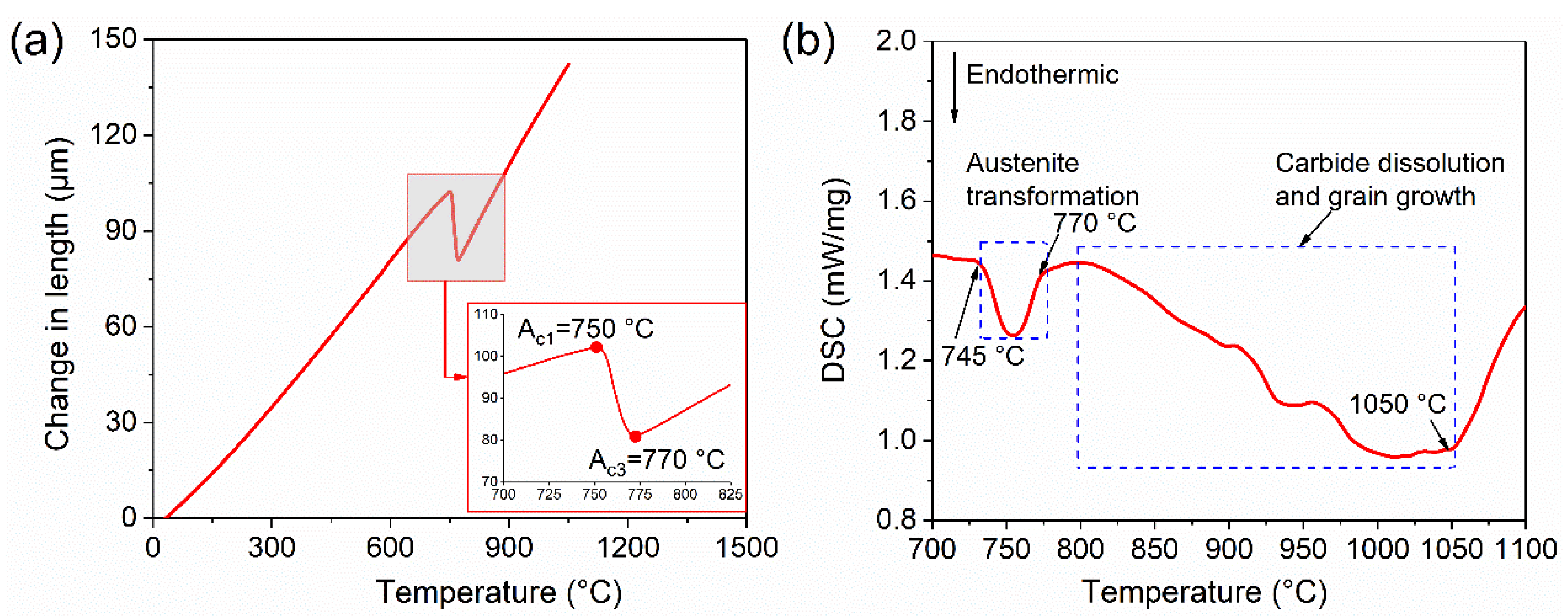
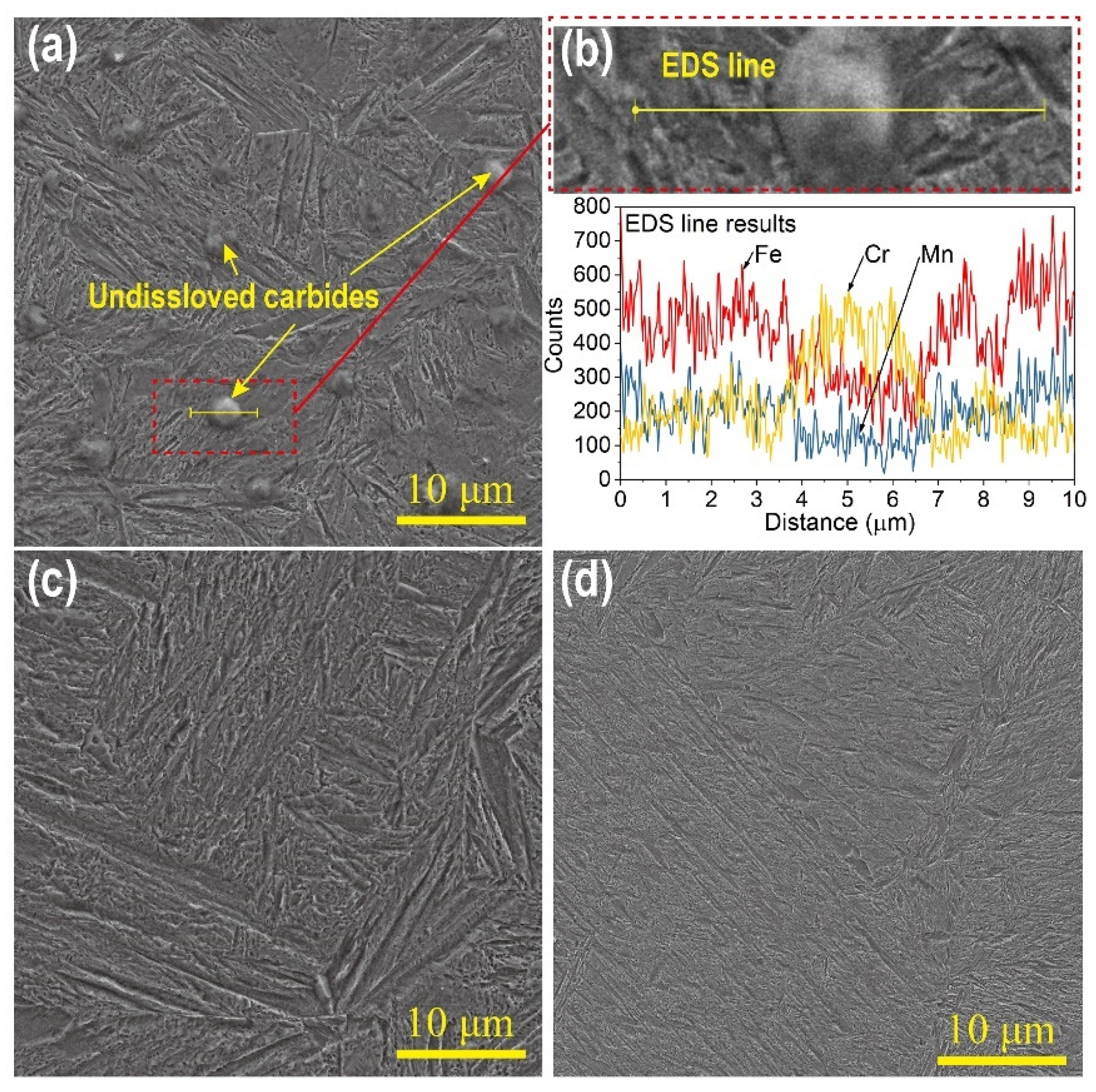
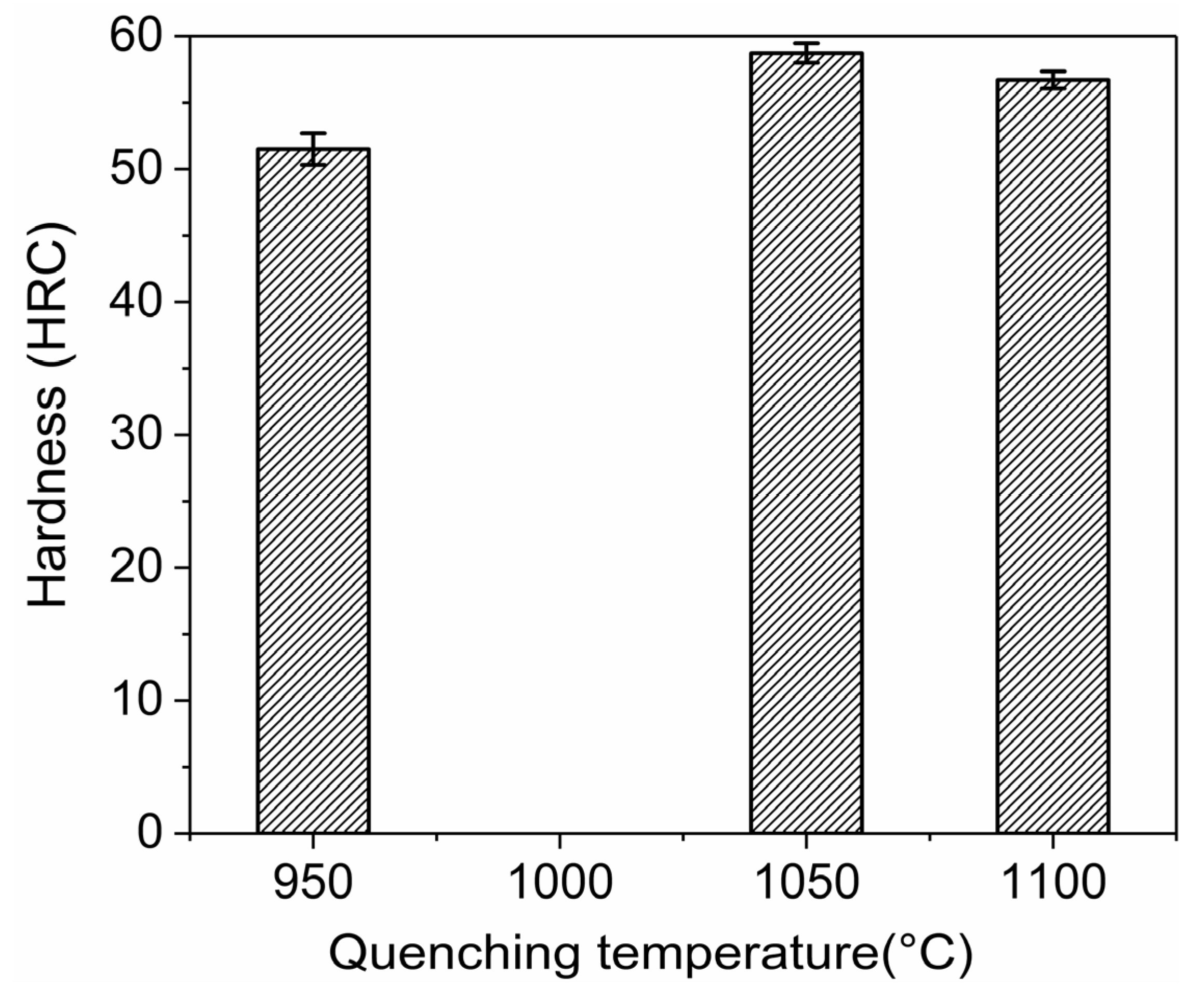
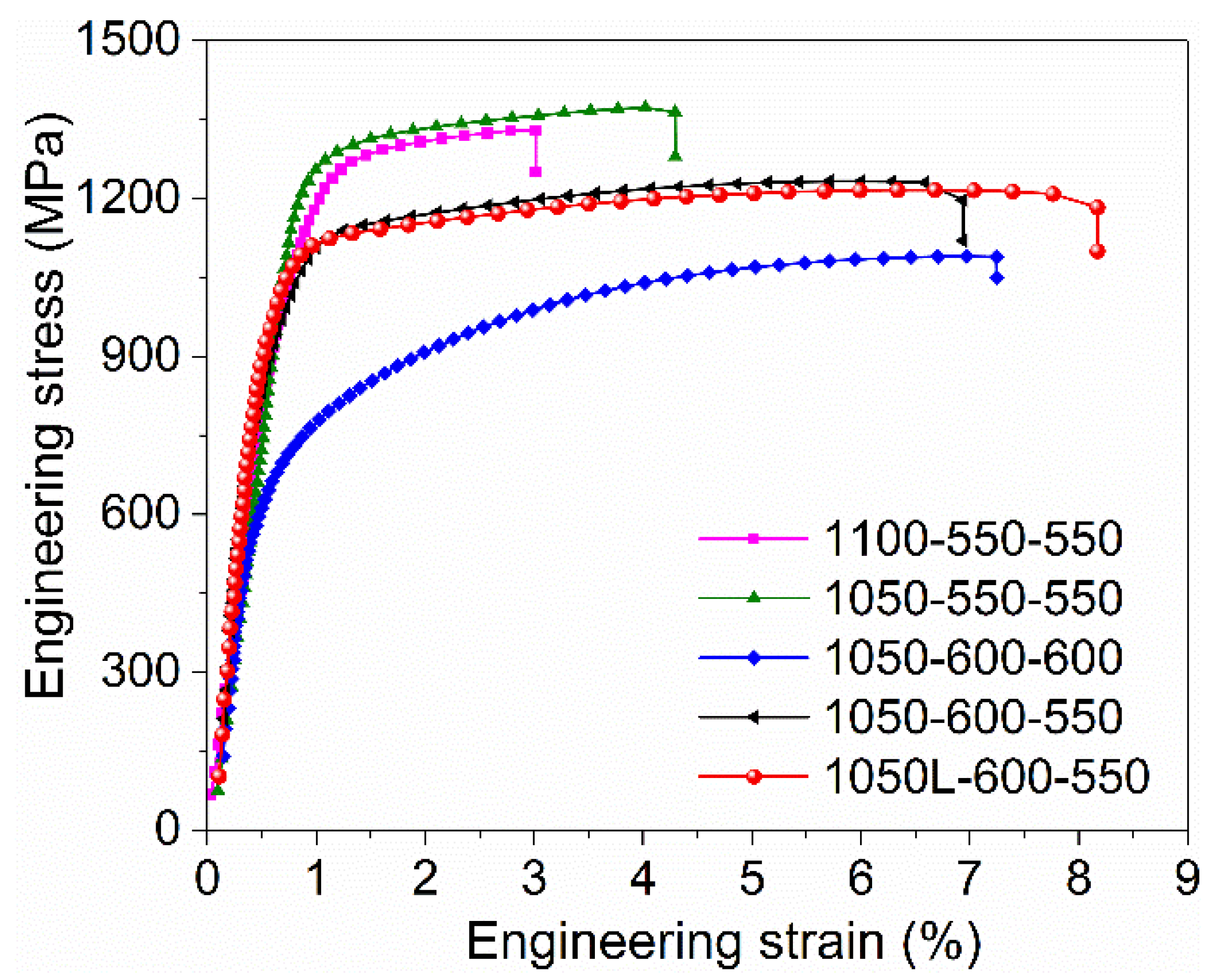
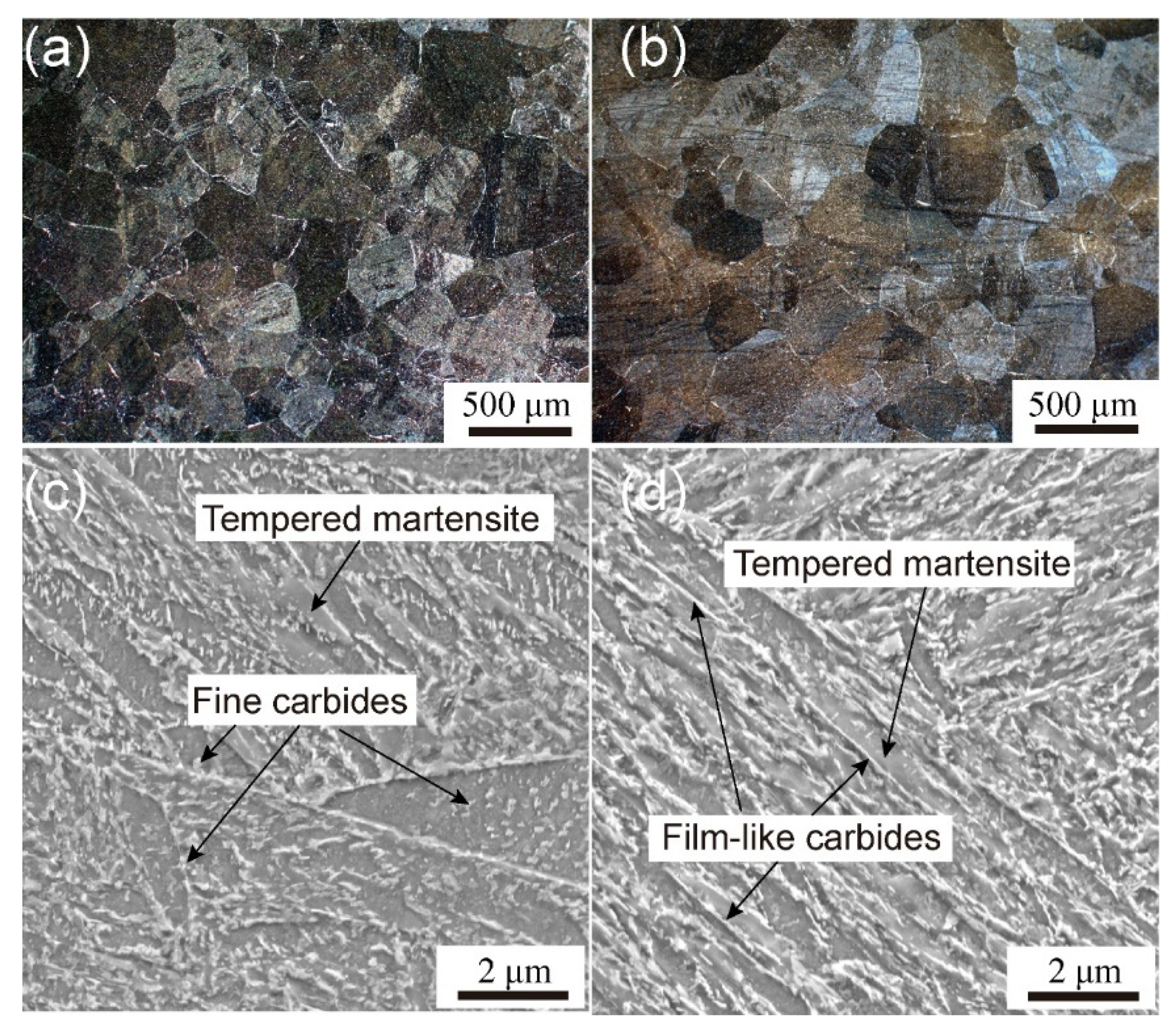
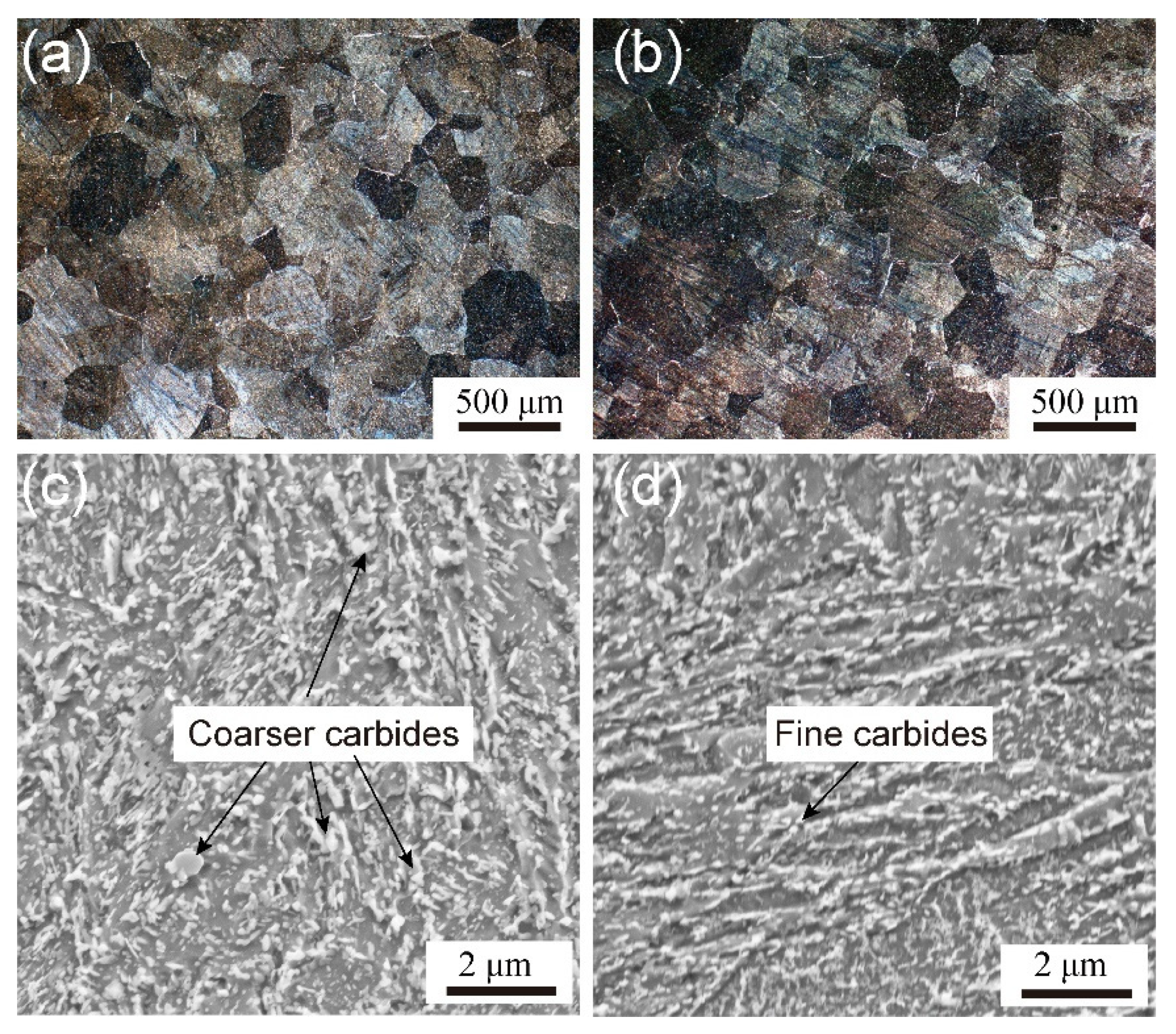
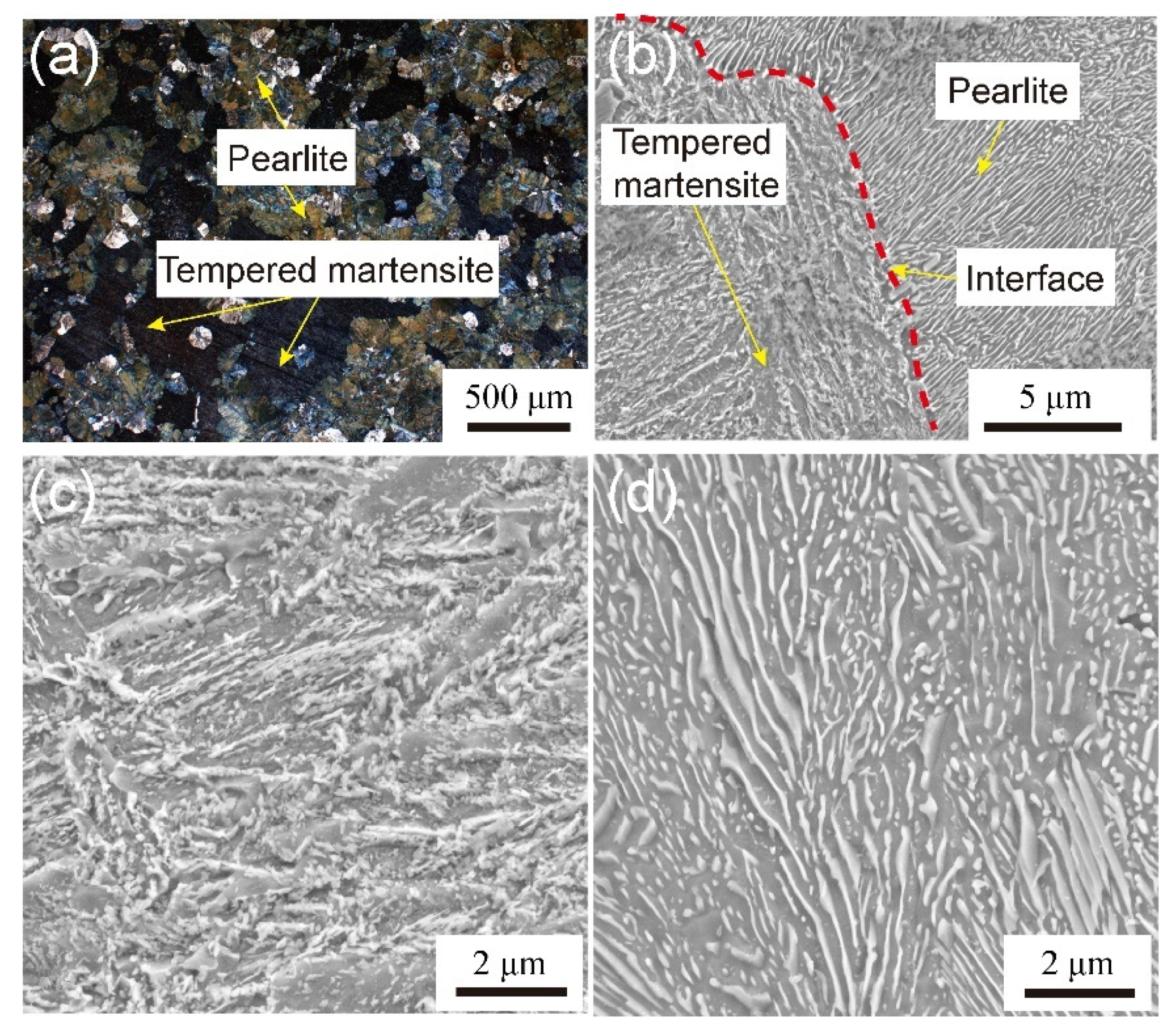

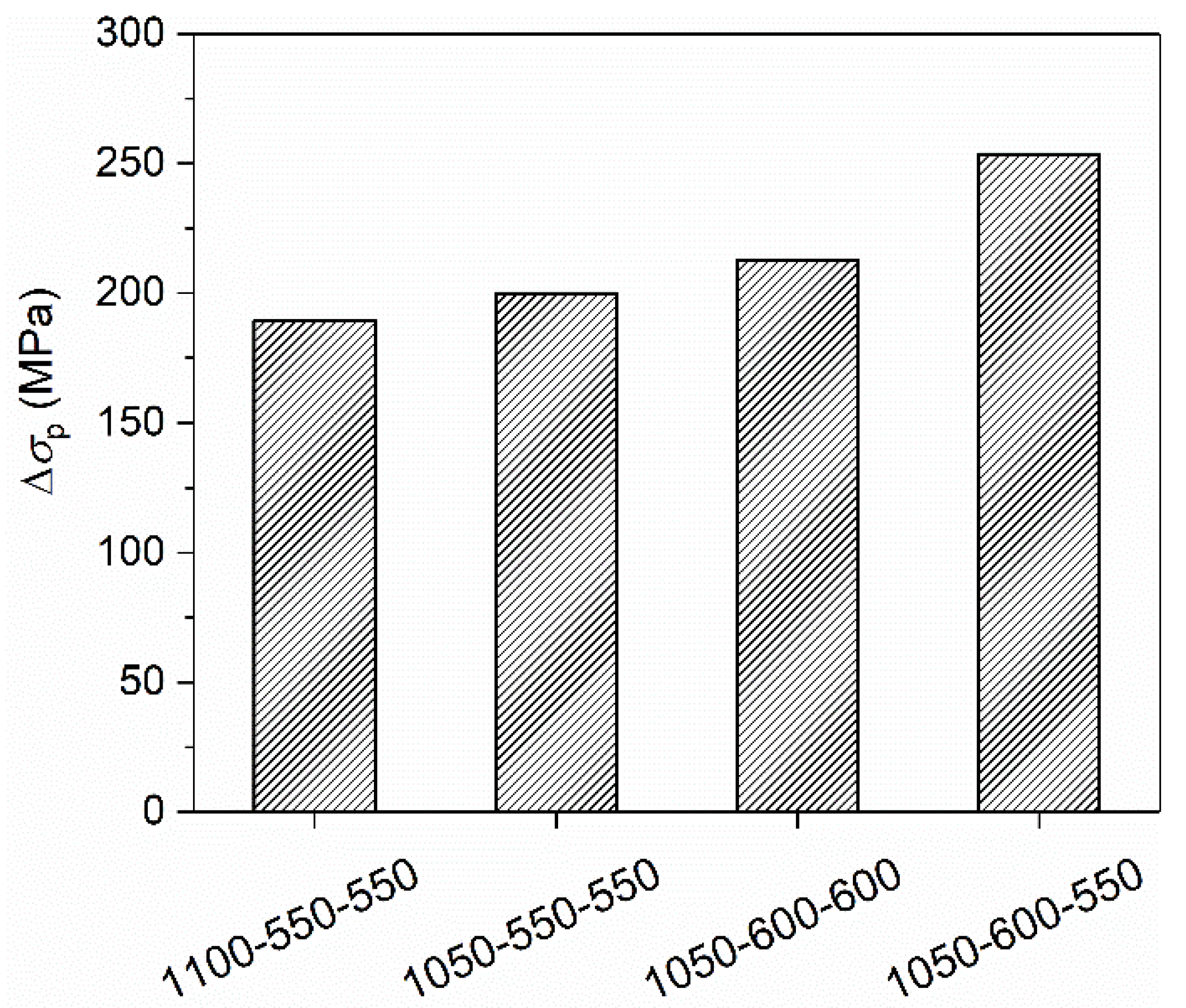
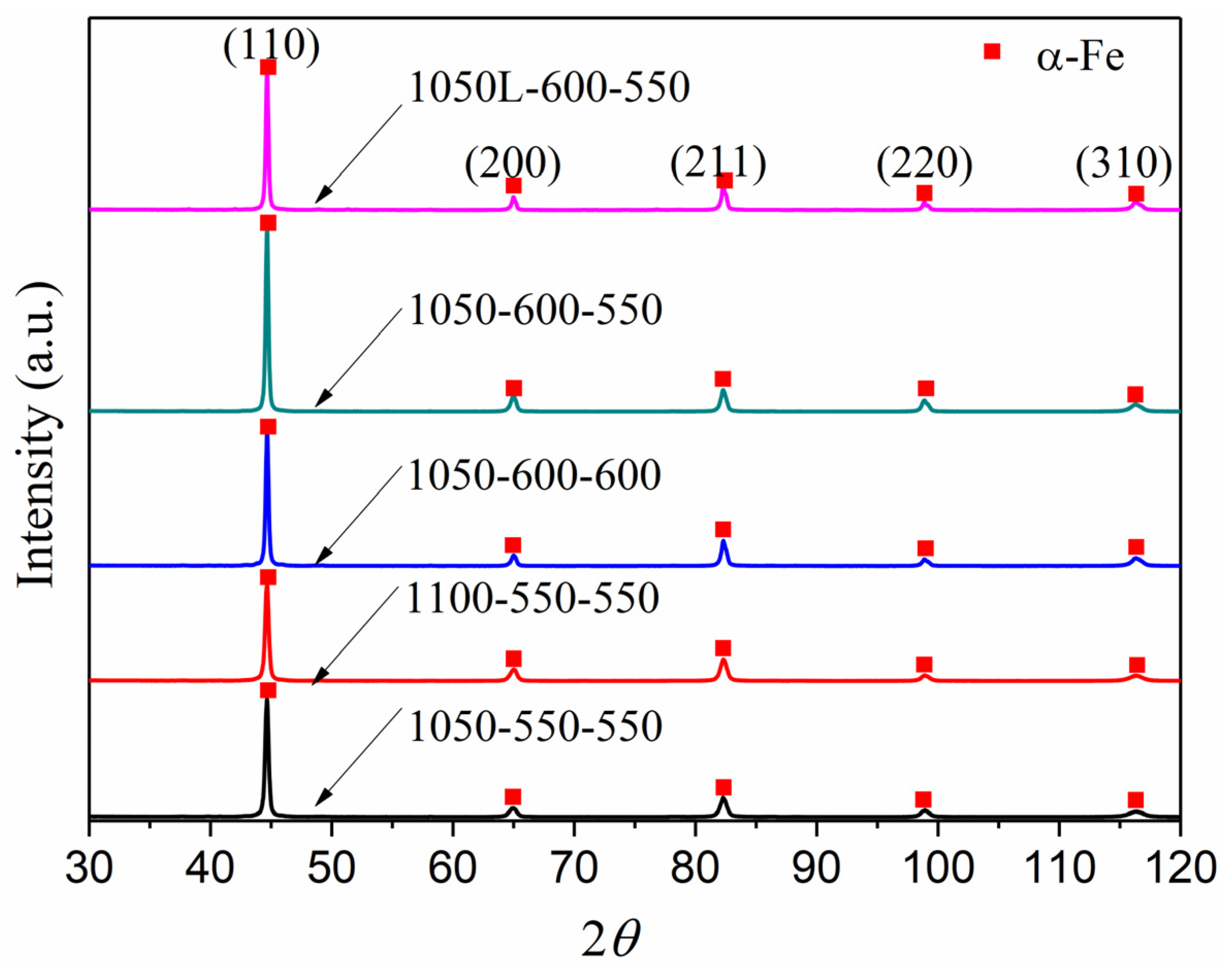
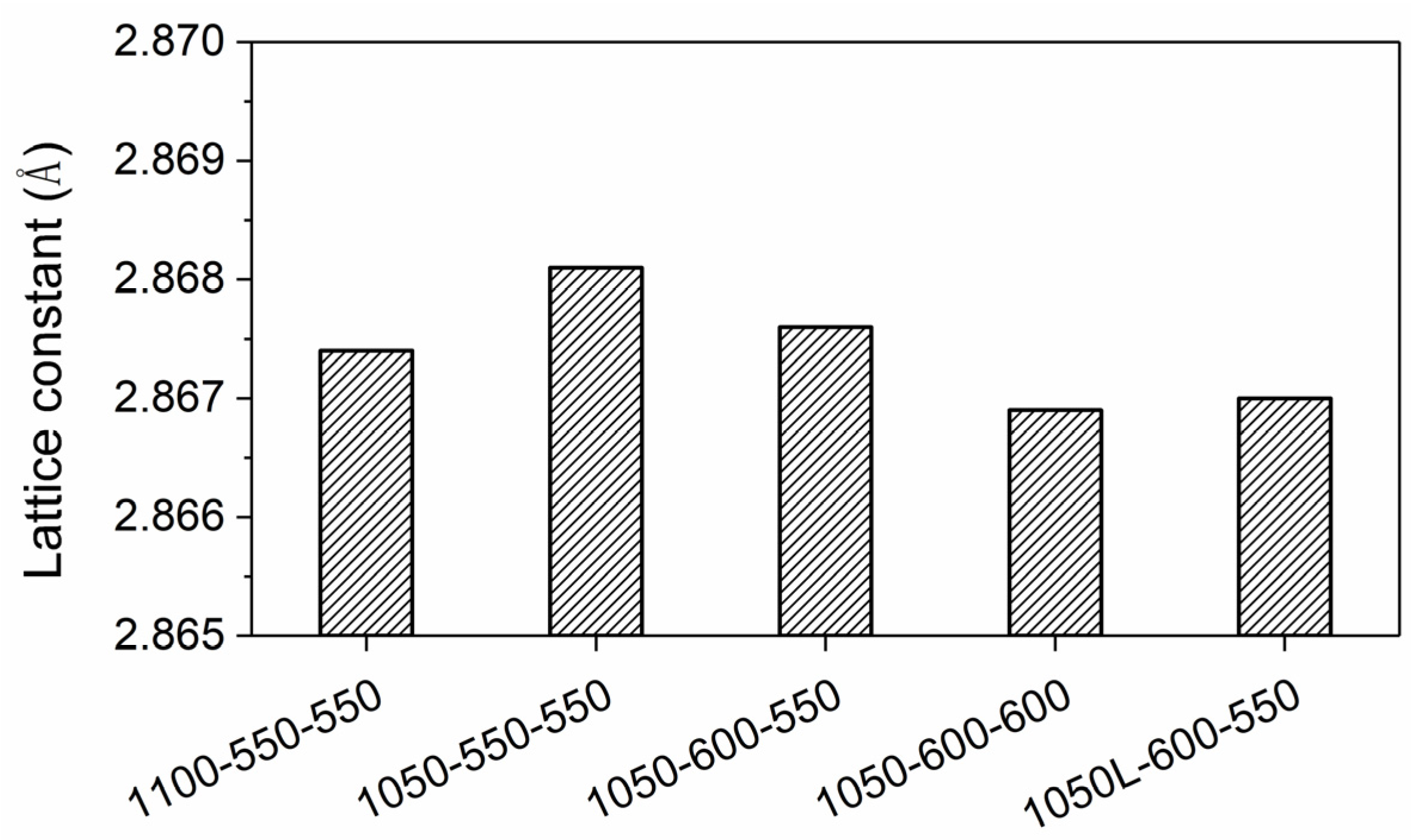


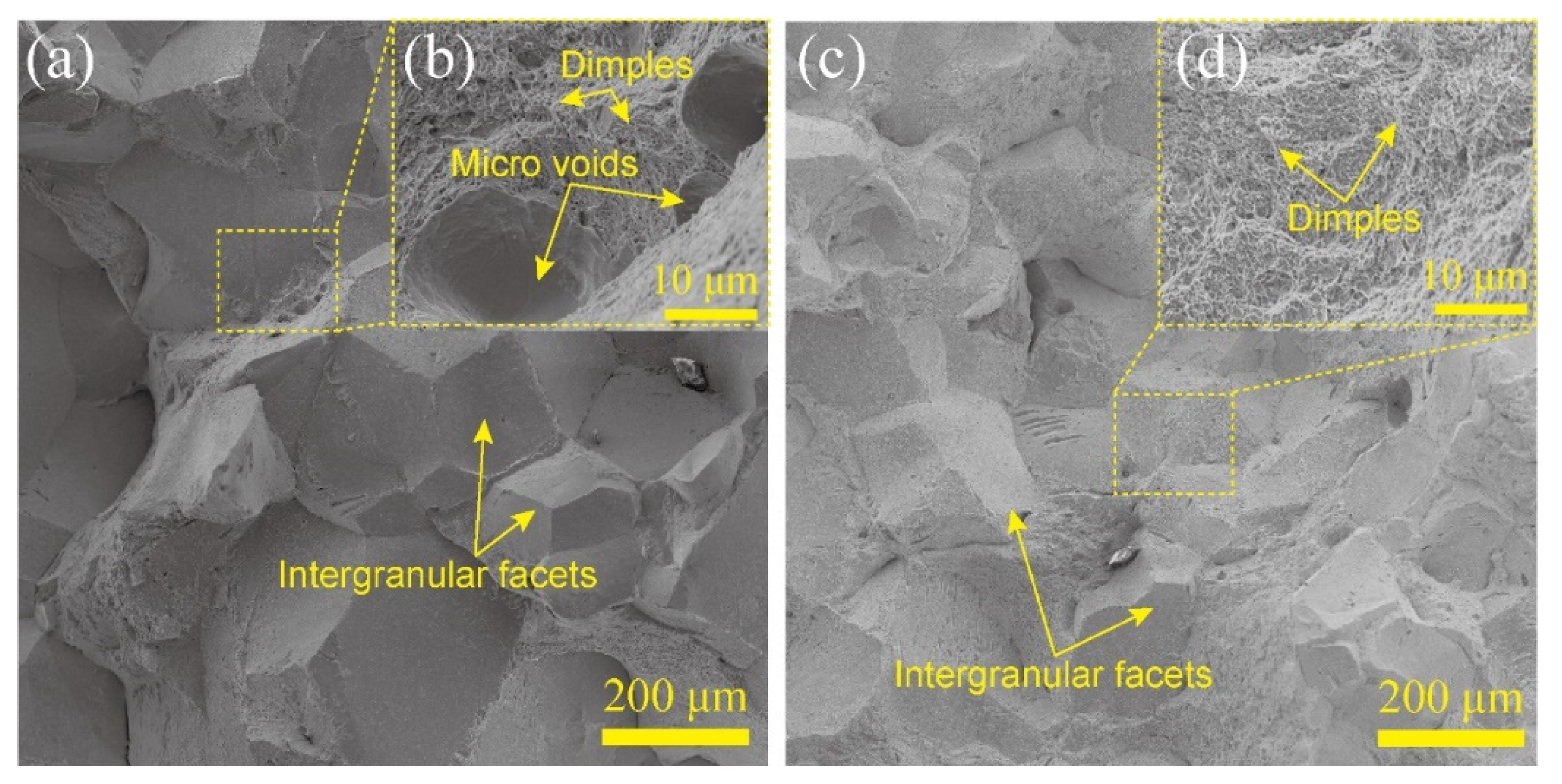

| Element | C | Si | Mn | Cr | Ni | Mo | V | P | S |
|---|---|---|---|---|---|---|---|---|---|
| wt.% | 0.54 | 0.25 | 0.72 | 0.96 | 1.58 | 0.36 | 0.074 | 0.012 | 0.003 |
| Specimen | UTS (MPa) | YS (MPa) | EL (%) |
|---|---|---|---|
| 1100-550-550 | 1330 ± 15 | 1200 ± 15 | 3.0 ± 0.5 |
| 1050-550-550 | 1375 ± 25 | 1290 ± 12 | 4.0 ± 0.8 |
| 1050-600-600 | 1090 ± 10 | 670 ± 8 | 7.0 ± 0.6 |
| 1050-600-550 | 1230 ± 20 | 1120 ± 10 | 7.0 ± 0.5 |
| 1050L-600-550 | 1220 ± 16 | 1110 ± 10 | 8.2 ± 0.3 |
Disclaimer/Publisher’s Note: The statements, opinions and data contained in all publications are solely those of the individual author(s) and contributor(s) and not of MDPI and/or the editor(s). MDPI and/or the editor(s) disclaim responsibility for any injury to people or property resulting from any ideas, methods, instructions or products referred to in the content. |
© 2023 by the authors. Licensee MDPI, Basel, Switzerland. This article is an open access article distributed under the terms and conditions of the Creative Commons Attribution (CC BY) license (https://creativecommons.org/licenses/by/4.0/).
Share and Cite
Huang, W.; Lei, L.; Fang, G. Optimizing Heat Treatment to Improve the Microstructures and Mechanical Properties of 5CrNiMoV Steel. Metals 2023, 13, 1263. https://doi.org/10.3390/met13071263
Huang W, Lei L, Fang G. Optimizing Heat Treatment to Improve the Microstructures and Mechanical Properties of 5CrNiMoV Steel. Metals. 2023; 13(7):1263. https://doi.org/10.3390/met13071263
Chicago/Turabian StyleHuang, Wanhui, Liping Lei, and Gang Fang. 2023. "Optimizing Heat Treatment to Improve the Microstructures and Mechanical Properties of 5CrNiMoV Steel" Metals 13, no. 7: 1263. https://doi.org/10.3390/met13071263
APA StyleHuang, W., Lei, L., & Fang, G. (2023). Optimizing Heat Treatment to Improve the Microstructures and Mechanical Properties of 5CrNiMoV Steel. Metals, 13(7), 1263. https://doi.org/10.3390/met13071263







